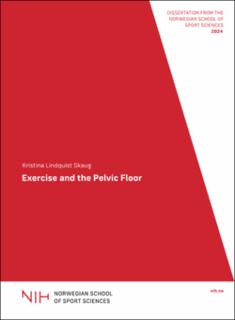| dc.description.abstract | Background: Exercise and strenuous work have been suggested, but not established, as possible risk factors for pelvic floor disorders (PFD) in women. Urinary incontinence (UI) has been shown to be highly prevalent in the female athletic population, especially in high-impact sports (such as trampolining, track and field and ball games). However, there is limited knowledge of extent and etiology of UI and other PFD in high-level gymnasts, cheerleaders and strengthathletes. Furthermore, there is a lack of knowledge of the impact of heavy weightlifting on the pelvic floor muscles (PFM) and effects of conservative treatments options for UI, such as PFM training (PFMT), in female strenuous exercisers.
Methods and aims: This doctorial project consist of four separate studies exploring various aspects of pelvic floor disorders in female athletes and exercisers. Study I was a survey of highlevel female artistic gymnasts (N = 68), team gymnasts (N = 116) and cheerleaders (N = 135) exploring the extent, associated factors and bothers of UI and AI. Study II was a survey of highlevel male (N = 204) and female (N = 180) Olympic weightlifters and powerlifters, exploring the extent, associated factors and bothers of UI, AI and pelvic organ prolapse (POP). Study III was an experimental crossover study where we assessed the acute effects of heavy weightlifting on the PFM’s resting pressure, strength, endurance, and resting activity in 47 nulliparous, strengthtrained women. Finally, study IV was an assessor-blinded randomized controlled trial evaluating the effects of PFMT on symptoms of UI in 47 strenuous female exercisers involved in CrossFit© and functional fitness.
Results and conclusion: In study I, the prevalence of UI and AI were 67% and 84%, respectively. The most common subtypes were stress UI (SUI, involuntary leakage of urine on physical effort), reported by 63% and involuntary loss of gas (81%). Age of 16 and 17, training ≥4 days/week, straining to void and type of sports (gymnastics vs. cheerleading) were significantly associated with SUI and years of training with AI. Eighty-three percent of athletes with SUI reported negative effect on sports performance. Forty-one percent had never heard about the PFM, but 74% reported an interest in PFMT to prevent/treat UI or AI. In study II, the prevalence of UI, AI and POP in females was 50%, 80% and 23% respectively. SUI was reported by 42% of the females and 88% of these reported negative influence on sport performance. Prevalence of UI and AI in males were 9% and 62%. Involuntary loss of gas was the most common subtype of AI among both males and females. In females, increasing body mass index (BMI) was significantly associated with SUI and international level of competition and weightlifting ≥4 days/week with AI. In males, increasing age and frequently straining to void were significantly associated with AI. Twenty one percent of the females and 59% of the males had never heard about PFM and most of the females (78%) and half of the males reported an interest in PFMT to prevent/treat PFD. In study III, we found no significant differences in change of PFM resting pressure (mean difference: 0.7 cmH2O, 95%CI: -0.8-2.2), strength (mean difference: -1.6 cmH2O, 95%CI: -5.1–1.8), endurance (median difference after exercise: 6, IQR: -24.5-26.5 vs. rest: 13, IQR: -15-40.2, p = 0.255) or resting activity (mean difference: 0.3, 95%CI: -0.9-0.5) when comparing the immediate effect of heavy weightlifting with the effect of rest. In study IV, we found that CrossFit© and functional fitness exercisers performing 16 weeks of PFMT had significantly larger improvement in symptoms and bother of the total score compared to the control group with a mean difference of -1.4 (95% CI: -2.6 to -0.2) of total score of the International Consultation on Incontinence Urinary Incontinence Questionnaire Short Form (ICIQ-UI-SF). The proportion of women reporting self-perceived improvement of SUI symptoms after 16 weeks was significantly larger in the PFMT group compared to the control group (64% vs. 8%, p < 0.001, RR: 8.0, 95% CI 2.0 to 31.2). None in the PFMT group and one participant in the control group reported worsening of symptoms. There were no significant differences in change of PFM resting pressure, strength, or endurance between groups, with mean differences of 1.3 (95% CI: -1.4 to 4.0), 3.8 (95% CI: -0.8 to 8.4) and 39.28 (95% CI: -1.5 to 80.1) respectively. Changes in symptoms of AI and POP were similar in both groups after 16 weeks. The participants in the PFMT group did not improve their self-efficacy for PFMT or beliefs in expected results after 1 month of training. | en_US |
